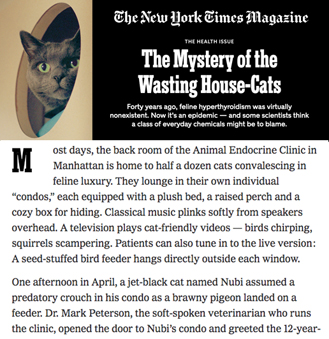Dr Peterson's Latest News
the new York times Magazine
The Mystery of the Wasting House-Cats: Forty years ago, feline hyperthyroidism was virtually nonexistent. Now it’s an epidemic — and some scientists think a class of everyday chemicals might be to blame.
Feline Endocrinology Textbook
Our primary goal for this book is to provide veterinarians, veterinary students, and others interested in cats with a concise and complete information resource on the pathophysiology, clinical signs, differential diagnosis, diagnosis, and treatment of endocrine disorders in cats.
New paper published in ANIMALS
Thyroid scintigraphy is an important tool for diagnosing and staging hyperthyroidism in cats, but it has not been evaluated for treatment success after radioiodine. In a study of 234 hyperthyroid cats, thyroid scans were performed before and six months after treatment. Based on thyroid blood tests, 165 cats (70.5%) returned to normal thyroid function, 54 cats (23.1%) had mild thyroid underactivity (subclinical hypothyroidism), and 15 cats (6.4%) developed more severe hypothyroidism. With follow-up scintigraphy, all cats showed a reduction in the size and activity of the overactive (“hot”) thyroid tumor tissue.
New paper published in JAVMA
Many hyperthyroid cats (15% to 50%) have concurrent chronic kidney disease (CKD) that is “masked” and will not become azotemic until after treatment. Previous studies reported that mild-to-moderate azotemic CKD after methimazole or thyroidectomy does not adversely affect survival. Our objective was to determine whether hyperthyroid cats with masked CKD rendered euthyroid with radioiodine (131I) have shorter survival than 131I-treated euthyroid cats that remain nonazotemic.




